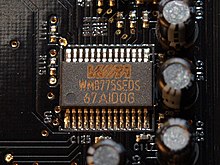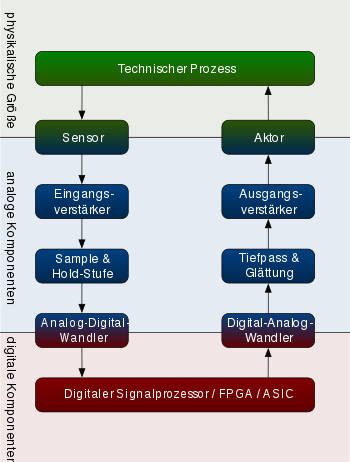Digital signal processing
Digital signal processing is a branch of communications engineering and deals with the generation and processing of digital signals using digital systems. In a narrower sense, its focus is on the storage, transmission and transformation of information in the sense of information theory in the form of digital, discrete-time signals. It has diverse and far-reaching applications in today's world and a strong influence on almost all areas of life, as it is one of the technical foundations of the digitalization of all modern communication technology and consumer electronics. This is also referred to as the Digital Revolution.
In practical application, almost all transmission, recording and storage methods for image and film (photo, television, video) and sound (music, telephony, etc.) are nowadays based on digital processing of the corresponding signals. Digital signal processing enables a wide range of conversion and processing methods for digital data, e.g. compression of audio and video data, non-linear video editing or image processing for photos. In addition, digital signal processing is also used - among many other industrial applications - in measurement and control technology and in medical technology, for example in magnetic resonance imaging. These developments are a consequence of the rapid progress in digital and computer technology (information technology) in recent decades. With the introduction of the music CD at the beginning of the 1980s, the above-mentioned "digitalization" began to influence people's everyday lives, which is most clearly seen today in the universal spread of versatile, multimedia-capable smartphones.
Digital signal processing is based on electronic components, such as digital signal processors (DSP) or powerful microprocessors, corresponding memory elements and interfaces for signal input and output. In the case of programmable hardware, the signal processing algorithms can be supplemented by additional software that controls the signal flow. Digital signal processing offers possibilities and processing options which could not be realized at all or only with great effort in the analog circuit technology used in the past.
The methods of digital signal processing are much closer to mathematics, such as the subfields of number theory or coding theory, than to classical electrical engineering. The starting point was the general awareness of the fast Fourier transform (FFT) starting in 1965 through a publication by J. W. Cooley and John Tukey. In addition, the practical possibilities of digital circuit technology improved in the same period, so that the newly developed methods could be applied.
.jpg)
Smartphone functions such as video recording, photography, video telephony and voice telephony itself are all based on digital processing of the respective image and sound signals from the built-in sensors (camera and microphone). The touchscreen also works via digital processing of the signals generated by the finger gestures.

Digital compression of video data made compact, high-resolution camcorders possible.

CD player from 1983. The compact disc marked the beginning of digital signal processing in the home.
Basic technical principle
The digital processing of a signal always follows the scheme Analog → Digital → Processing → Analog. The changes to the signal are made exclusively in the digital domain. The procedure is explained using the example of an audio CD:
- During a sound recording, the sound pressure is converted into an analog AC voltage via a microphone. This alternating voltage is converted into a sequence of digital values with the help of an analog-to-digital converter.
For audio CDs, the following values are used:
- a sampling rate of 44.1 kHz, i.e. the signal is sampled 44,100 times per second
- a word width of 16 bits, i.e. the sampled, continuous value is mapped to one of 65,536 discrete values
- In an intermediate step, the digital audio signal can now be processed, e.g. filtered or provided with effects, before it is stored.
- To store the audio signal, the individual values are written to the audio CD in sequence.
- To play back the sound recording later, the data is read from the CD and converted back into a continuous AC voltage by a digital-to-analog converter. This is then transmitted to the speakers or an amplifier.

Integrated electronic circuit (chip, in the center of the picture) with analog-to-digital converters for converting analog audio signals into a digital data stream, here on a PC sound card.

Processing scheme of digital signal processing
Structure of a digital signal processing system
The diagram shows the typical structure of a signal processing system, which always has analog components at the interface to the "outside world". Only the red-colored components in the lower part of the diagram belong to the digital signal processing system in the narrower sense.
Let's follow the path of the signals in the graphic: By means of a sensor, physical quantities are converted into an, often weak, electrical signal. This signal is boosted for further processing, e.g. with the help of an operational amplifier, to the level required for the subsequent steps. From the amplified analog signal, the sample-and-hold stage samples values at specific time intervals and holds them constant during an interval. Thus, a continuous-time analog curve becomes a discrete-time analog signal. A signal that is constant for a certain time is required by the analog-to-digital converter to determine the discrete digital values. These can then be processed by the digital signal processor. The signal then takes the reverse path and can be fed back into the technical process via an actuator if necessary.

Digital signal processing system
Questions and Answers
Q: What is digital signal processing (DSP)?
A: Digital signal processing is concerned with the processing of digital signals or analog signals after converting from analog to digital format.
Q: What are some subfields of DSP?
A: Some subfields of DSP include communication signals processing, radar signal processing, sensor array processing, and digital image processing.
Q: How is DSP used in our lives?
A: DSP is usually used with real-world analog signals found in our lives.
Q: What is the first step in processing a real-world analog signal with DSP?
A: The first step is usually to convert the signal from an analog to a digital form, by using an analog-to-digital converter.
Q: What is required to convert a digital signal back to an analog form?
A: Often, the required output signal is another real-world analog signal, which requires a digital-to-analog converter.
Q: What can digital signal processing algorithms run on?
A: Digital signal processing algorithms can run on various processing platforms including computer CPUs and digital signal processors.
Q: What are some areas that use digital signal processing in their applications?
A: Digital signal processing is used in fields such as telecommunications, medical imaging, and audio processing.
Search within the encyclopedia